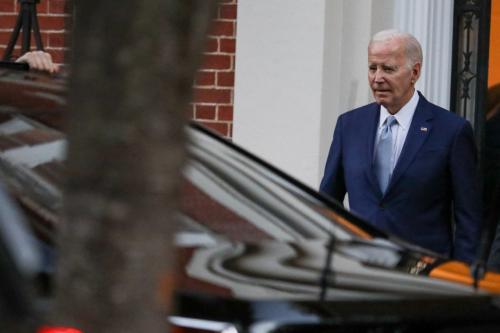In 2024, can the Biden administration and the Senate move Biden’s judicial confirmation numbers — so-so at the end of 2023 — to the levels anticipated by his record first-year confirmations? Can they continue to change the face of the judiciary?
Watch for developments in four areas:
- The pace of confirmations (robust so far);
- Nominees to district courts with Republican senators (on the increase);
- Potential effects of those nominees on the judiciary’s demographic make-up, and;
- Appellate court vacancies (scarce so far).
Figure 1 shows that Biden’s 40 first-year confirmations easily topped all four recent predecessors, but his 165 three-year confirmations topped only Obama; Trump topped them all.
Overall
- Can the Senate maintain its aggressive confirmation pace in 2024?
Although Biden’s three-year confirmation numbers lag behind three of his four recent predecessors, the 2021-23 Senate’s pace of confirmations was surprisingly robust, given the Democrats’ thin majority and many Republican senators’ routine no votes on every nominee. Forty percent of Biden’s district nominees received 45 or more no votes, leaving little room for Democratic senators’ defections or absences. (Trump had a greater Senate majority and only six percent of his district nominees got 45 or more no votes. On court of appeals confirmations, Trump and Biden nominees’ 45-plus no votes were both in the 30% to 40% range.).
The Senate’s confirmation rate of 88% of Biden district nominees is better than Trump’s 83% and second only to Clinton’s 92%.1 And the Senate confirmed Biden’s district nominees in median days of 149 compared to 259 for Trump. Biden’s circuit nominees were confirmed at a 91% rate — second only to Trump’s 96% — and confirmed slightly faster than Trump’s: 137 median days versus 146.
The key here is number of nominations. Biden’s district confirmation rate was higher than Trump’s, but Trump submitted 177 district nominees in his first three years, compared to Biden’s 157. He submitted 53 appellate nominees compared to Biden’s 45.
Biden needs a faster nomination pace, although Republican senators have threatened to cease even minimal cooperation on nominations because of a stepped-up Democratic Supreme Court “ethics probe.” If they carry through, more robust nominations may not make a difference, especially if Democratic senators in tight reelection bids are wary of voting to confirm controversial nominees.
The district courts
Biden needs 51 more district confirmations in 2024 to match Trump’s four-year total of 177 and slightly fewer to match Clinton and Bush.
Twenty-seven nominees were pending at the end of 2023 session. Were Biden to renominate them all and the Senate to confirm them all — an unlikely scenario — he would still need to send the Senate at least 24 more nominees, not all of whom would likely get confirmed. Rough guess: The minimum number of additional nominations needed is probably upwards of 30 or 35.
- Can Biden continue to expand district court nominations to vacancies in states with Republican senators?
To get at least 35 nominees submitted, Biden will need to increase the proportion of nominees to red and purple states, despite senators’ “blue-slip” veto power over whether home-state district nominees get hearings and votes. That obliges administrations to negotiate to find nominees that the senators won’t block, and those negotiations are likely to be more difficult and lengthier with opposition party senators.
To date, only 19% of Biden’s nominees to district courts in states (excluding, e.g., the District of Columbia) were to red or purple states but of the 55 current and announced vacancies without nominees, 33 are in states with a Republican senator. Absent a big increase in blue state vacancies, Biden will need to continue the upward trend of red and purple state nominations: four in 2021, eight in 2022, and 20 in 2023.
By contrast, 85 (51%) of Trump’s three-year nominations were to vacancies in states with other-party senators — proportionately over twice as many such nominees as Biden’s. Perhaps Republican home-state senators in 2021-2023 wielded their blue-slip veto more aggressively than did Democratic senators in 2017-2019. Median days from vacancy to nomination is suggestive: For nominees to courts with other-party senators, median days were 461 for Trump versus 534 for Biden (for same-party senator states, time was about the same — 255 for Trump, 261 for Biden).
Another reason, however, may be greater Trump administration willingness to trade some ideological affinity for more confirmations. In fact, the Trump administration renominated 13 failed Obama nominees. Six were 2017 red-state renominations (as in Idaho, a failed late-term Obama nomination negotiated with Republican senators), but most of the other seven were later blue-state renominations of candidates who were not natural Trump administration picks, as in Rhode Island. Biden, by contrast, has renominated only two Trump nominees, both to New York seats.
- What effect, if any, will increased nominations to red and purple state district court vacancies have on Biden’s effort to create a demographically diverse bench?
Biden regularly extols his efforts to “ensure that the nation’s courts reflect the diversity that is one of our greatest assets as a country.” His 165 district and circuit appointments include only 18 white males. Negotiations with Republican senators necessary to increase district nominations to their states may dilute the diversification trend. It’s early, but of the 32 district nominees to red and purple states so far, 31% are white males, versus 13% of the 125 nominees to courts in blue state and no-senator jurisdictions. No such difference appears among court of appeals nominees, about whom home-state senators have no blue-slip veto.
Other effects of blue-slip provoked negotiations with Republican senators may take longer to unpack. Whether Biden’s appointees to red and purple state vacancies will display different decisional tendencies than his other appointees — and the same question for Trump appointees — might become grist for master’s degree theses.
Courts of appeal
- Will enough court of appeals vacancies occur to let Biden match Trump’s 54 appointees?
Biden’s 39 three-year confirmations already outpace Clinton’s, Bush’s, and Obama’s four-year totals but lag well behind Trump’s.
Again, the difference in confirmations reflects more nominations — 53 Trump nominees in three years versus 45 Biden nominees.
Biden’s road to the 15 confirmations he needs to match Trump’s 54 starts with four pending nominees and three vacancies that await nominees. Even with seven confirmations — which is iffy at best — Biden needs eight active status circuit judges to leave active status and thus create vacancies. I reported a year ago that 16 Democratic-appointed judges were eligible to leave active status with a salary or pension. Since then, an additional judge became eligible, but that judge and another left active status and one more has announced his intention to do so. Thus, for present purposes, the number of active-status-eligible Democratic appointees is at 14.
Whether any eight of them will leave active status in 2024 is doubtful — most have been eligible for at least five years, some much longer. And were eight vacancies somehow to appear, could Biden get nominees in place and confirmed by the end of the year? That may depend on how many such vacancies are created by the seven eligible judges in red or purple states. Even though home-state senators have no blue-slip veto over circuit nominees, Biden’s 12 nominees to red or purple states took 281 median days from vacancy to nomination and the 10 who got confirmed did so in 223 median days — about twice as long as blue-state nominees.
Conclusion
Any number of things could occur in 2024 to confound this analysis: Unexpected court of appeals vacancies or a shutdown of the Senate confirmation process are just two of the possibilities. For now, it appears likely that the administration can’t match Trump’s circuit confirmation numbers but might match his district numbers, albeit with hard-to-predict side effects on the types of nominees — less diverse, for example, and less liberal than most Biden nominees.
-
Footnotes
- The rate is based on nominees through October of the third year.
The Brookings Institution is committed to quality, independence, and impact.
We are supported by a diverse array of funders. In line with our values and policies, each Brookings publication represents the sole views of its author(s).








Commentary
Biden’s effort to reshape the federal judiciary: Four things to watch in 2024
January 10, 2024